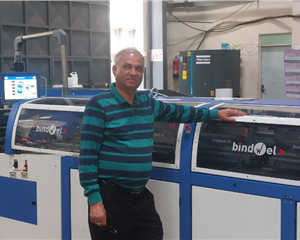With six machines already been sold since January 2017, the company hopes to close this calendar year with nine flexo presses. In conversation with Gourav Roy of FIG
How have been the last couple of years for FIG?
In 2016, we installed 16 Mark Andy flexo presses and 20 Rotoflex slitter-rewinders in India. Since January 2017 we have installed six presses. The aim is to sell another two to three presses by December.
It’s been tough in 2017?
The number of presses in 2017 may seem lower, but interestingly the value of these presses is quite higher. This is because we have seen lesser entry-level presses and more number of high-end machines with heavy-duty configurations.
What are the configurations?
We are talking about P7 and P5 presses and the longer configurations.
You mean the market has matured. Are converters moving from low-end machines to high-end ones?
Four years ago, 70% of our business accrued from entry-level presses. There were a lot of new players who ventured into the label printing business and hence many entry-level presses were installed. Today, the market is consolidating.
Why?
In the last couple of years it is the existing label printing companies who are either adding capacities or finding niche applications like security printing, in-mould labels, shrink sleeves, speciality labels etc. Hence they are opting for longer machines, special configurations.
How do you see the label printing business in India grow?
The label printing business is in a flux. The regular vanilla label no longer attracts margins. Value addition has become a necessity. Therefore, it is one of the key function of the machine manufacturers to enable the printers add value to the labels.
What’s the potential for digital?
As far as digital is concerned, we have hybrid presses on offer. We anticipate Digital One to create a lot of excitement in the Indian market when we install it at Barcom. It’s an economical product and lot of people will be able to opt for it.
Will they opt for it?
In India, the printers need to understand the value of the time. Today, the focus of Indian label printers is on offering its customers something different and earning a premium on it. However, they should look at how to maximise their efficiencies on the shopfloor and thereby bolster the value of the output. This culture is slowly being inculcated among the Indian label converters.
Please elaborate...
What’s the use of a machine with a speed of 120 metres per minute if the operator is not able to operate above 70 metres per minute. I keep getting queries as to how quick is the machine changeover. One must realise that when you are talking about changeover times, the efficiency on the shopfloor should be so high that when one job is over, all the necessary things for the next job must be ready for the operator to switch the job immediately. Otherwise you won’t be able to use your new press to its full potential. When one buys a new press there are lot of small things that one needs to consider such as metering rollers, bearings etc. Most buyers don’t ask for these things and the sales person is not interested in making the customer aware because it will make the proposition expensive.
How?
Consider, I am selling an eight-colour press with only eight doctor blades. So for the printer, when one job is completed and the next job has different set of colours, then the printer will have to clean the doctor blades for the new job. In case of a well-informed buying decision, the buyer will ask an additional set of doctor blades, ink pans, metering rollers etc which has to be integral part of the first purchase. In this sense, I must say that the Indian printers have, lately, started making well-informed purchases.
There’s a lot of buzz around servo motors. How important are servo motors while buying a new press?
It’s actually confusing. Some talk about servo motors, some talk about controllers, KLS machines, stability etc. The important parameter to look at is how to control the register and reduce the changeover time and wastages. We tend to confuse the label converters when we talk about what servo motors can do. Instead, we should be talking about what are our press is capable of and not about servo motors. I have even seen suppliers assure servo motors in the presses, however, there are none. If I give a servo on a line shaft, I can declare the machine to be servo-driven but how does it help? There is a servo at the end and at the beginning but I am not controlling any processes in between individually. Then, what’s the use of servo? A converter needs to understand these aspects. One must also understand the servo motor family – there are brushless motors, AC motors, DC motors etc. Every motor functions differently, prices are different. But you can confuse converters and tell them they are servos.
Today, we see machines being controlled with an iPad from a remote location. The question is, the lack of skilled labour in India; and the mismatch in the technological advancements and skills to run a machine?
Without having the knowledge of printing, without knowing how to run a press, a lay man cannot run a press on an iPad. We at Mark Andy offer something unique, a training opportunity at Mark Andy University, USA wherein the machine buyer can send three operators for two-week training.
Tell us something about the P7 that is not printed in your posh brochure?
One is the Digital Plus Screen process. It is an inline digital print bar that serves as cost-effective alternative to traditional rotary screen. It uses the same printheads and ink chemistry as Digital Series to deliver richly pigmented output with the added capability of printing reverse text, barcodes, and sequential numbering in a single pass. Two, this machine can be configured from 10-inch to 22-inch width. This can cover a large gamut of applications and do multiple laminations and flexible packaging very well. There are different models for these sizes.














 See All
See All